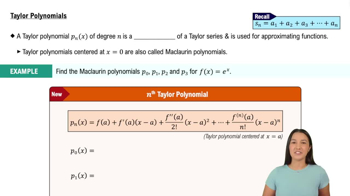Let f(x) = (4x³ + x² + 4x + 2) / (x² + 1). Use long division to show that f(x) = 4x + 1 + 1 / (x² + 1) and use this result to evaluate ∫f(x) dx.
Table of contents
- 0. Functions7h 54m
- Introduction to Functions16m
- Piecewise Functions10m
- Properties of Functions9m
- Common Functions1h 8m
- Transformations5m
- Combining Functions27m
- Exponent rules32m
- Exponential Functions28m
- Logarithmic Functions24m
- Properties of Logarithms36m
- Exponential & Logarithmic Equations35m
- Introduction to Trigonometric Functions38m
- Graphs of Trigonometric Functions44m
- Trigonometric Identities47m
- Inverse Trigonometric Functions48m
- 1. Limits and Continuity2h 2m
- 2. Intro to Derivatives1h 33m
- 3. Techniques of Differentiation3h 18m
- 4. Applications of Derivatives2h 38m
- 5. Graphical Applications of Derivatives6h 2m
- 6. Derivatives of Inverse, Exponential, & Logarithmic Functions2h 37m
- 7. Antiderivatives & Indefinite Integrals1h 26m
- 8. Definite Integrals4h 44m
- 9. Graphical Applications of Integrals2h 27m
- 10. Physics Applications of Integrals 3h 16m
- 11. Integrals of Inverse, Exponential, & Logarithmic Functions2h 34m
- 12. Techniques of Integration7h 41m
- 13. Intro to Differential Equations2h 55m
- 14. Sequences & Series5h 36m
- 15. Power Series2h 19m
- 16. Parametric Equations & Polar Coordinates7h 58m
7. Antiderivatives & Indefinite Integrals
Indefinite Integrals
Problem 8.1.38
Textbook Question
7–64. Integration review Evaluate the following integrals.
38. ∫ x / (x⁴ + 2x² + 1) dx
 Verified step by step guidance
Verified step by step guidance1
Step 1: Observe the integrand ∫ x / (x⁴ + 2x² + 1) dx. Notice that the denominator can be factored. Rewrite the denominator as (x² + 1)², since x⁴ + 2x² + 1 is a perfect square trinomial.
Step 2: Substitute u = x² + 1 to simplify the integral. Compute the derivative of u with respect to x: du/dx = 2x, which implies du = 2x dx.
Step 3: Rewrite the integral in terms of u. Substitute x dx with (1/2) du, and the denominator becomes u². The integral now becomes (1/2) ∫ 1/u² du.
Step 4: Apply the power rule for integration to ∫ 1/u² du. Recall that ∫ u⁻² du = -u⁻¹ + C, where C is the constant of integration.
Step 5: Substitute back u = x² + 1 into the result to express the solution in terms of x. The final answer will be in the form of -1/(x² + 1) + C.
 Verified video answer for a similar problem:
Verified video answer for a similar problem:This video solution was recommended by our tutors as helpful for the problem above
Video duration:
2mPlay a video:
Was this helpful?
Key Concepts
Here are the essential concepts you must grasp in order to answer the question correctly.
Integration Techniques
Integration techniques are methods used to find the integral of a function. Common techniques include substitution, integration by parts, and partial fraction decomposition. Understanding these methods is crucial for evaluating more complex integrals, such as the one presented in the question.
Recommended video:

Integration by Parts for Definite Integrals
Polynomial Functions
Polynomial functions are expressions that involve variables raised to whole number powers. In the integral ∫ x / (x⁴ + 2x² + 1) dx, the denominator is a polynomial of degree four. Recognizing the structure of polynomial functions helps in simplifying the integral and determining appropriate integration techniques.
Recommended video:

Taylor Polynomials
Rational Functions
Rational functions are ratios of two polynomial functions. The integral in the question involves a rational function, which can often be simplified or decomposed for easier integration. Understanding how to manipulate rational functions is essential for effectively evaluating integrals like the one given.
Recommended video:

Intro to Rational Functions

 5:04m
5:04mWatch next
Master Introduction to Indefinite Integrals with a bite sized video explanation from Patrick
Start learningRelated Videos
Related Practice
Textbook Question
26
views
